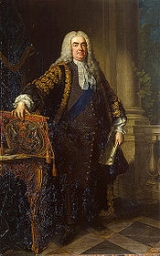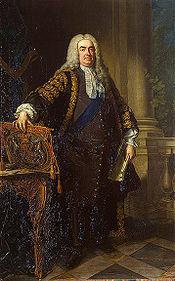
Norfolk Biffin
Encyclopedia
The Norfolk Biffin is a local apple
cultivar
originating from the English
county of Norfolk
.
'Beefing' is thought to be a corruption of biffin.
. The apples store well, getting sweeter with keeping, and are good for cooking and drying. By March of the year after harvesting, they are sweet enough to use as dessert apples. With keeping, they turn a deeper brown or maroon colour, with harder, more solid flesh.
These apples were popular with Norwich
bakers and were sent to London fruiterers as a delicacy. They were also used for cider
making.
The trees are vigorous, with heavy crops of fruit. Some thinning is necessary in good years.
 The Norfolk Biffin is an apple variety grown over some three hundred years, often for drying to make 'biffins' (viz., "a baked apple flattened in the form of a cake").
The Norfolk Biffin is an apple variety grown over some three hundred years, often for drying to make 'biffins' (viz., "a baked apple flattened in the form of a cake").
The estate records for Mannington, Norfolk
, dating from 1698, of Robert Walpole
(later the first Prime Minister
of Great Britain
) mention Norfolk Biffin apples which Walpole had sent up to his house in London
. The apple is documented in the United States
from the 1840s.
The Norfolk Biffin is also mentioned by Charles Dickens
, first in A Christmas Carol
(1843), later in Dombey and Son
(1846-1848) and in Boots at the Holly-tree Inn (1858). The first of these says: "Norfolk Biffins, squab and swarthy, setting off the yellow of oranges and lemons, and in the great compactness of their juicy persons, urgently entreating and beseeching to be carried home in paper bags and eaten after dinner". The last of these has: "Cobbs, do you think you could bring a biffin, please?... I think a Norfolk biffin would rouse her, Cobbs. She is very fond of them."
The Victorian food writer and poet Eliza Acton
recommends the apple in her Modern cookery, in all its branches (1845) as the best apple to use when baking 'Black Caps par Excellence' (a sugared baked apple made with wine and lemon peel): "The Norfolk biffin answers for this dish far better than any other kind of apple".
A recipe for biffins of 1882 advises: "... choose Norfolk Biffins with the clearest most blemish free rinds, then lay them on clean straw on baking wire and cover well with more straw. Set them in a very slow oven for four to five hours. Draw them out and press them very gently, otherwise their skins will burst. Return them now to the oven for another hour, then press them again. When cold, rub them over with clarified sugar".
In Victorian London, there was a Christmas trade in biffins, supplied by Norwich bakers, who cooked the apples in their bread-ovens, weighed down with an iron plate to exclude air.
The apple is now only rarely seen in English orchards, having been widely replaced by such varieties as the Cox's Orange Pippin
. However, it is still grown by gardeners for home consumption and the cultivar can still be bought commercially.
Apple
The apple is the pomaceous fruit of the apple tree, species Malus domestica in the rose family . It is one of the most widely cultivated tree fruits, and the most widely known of the many members of genus Malus that are used by humans. Apple grow on small, deciduous trees that blossom in the spring...
cultivar
Cultivar
A cultivar'Cultivar has two meanings as explained under Formal definition. When used in reference to a taxon, the word does not apply to an individual plant but to all those plants sharing the unique characteristics that define the cultivar. is a plant or group of plants selected for desirable...
originating from the English
England
England is a country that is part of the United Kingdom. It shares land borders with Scotland to the north and Wales to the west; the Irish Sea is to the north west, the Celtic Sea to the south west, with the North Sea to the east and the English Channel to the south separating it from continental...
county of Norfolk
Norfolk
Norfolk is a low-lying county in the East of England. It has borders with Lincolnshire to the west, Cambridgeshire to the west and southwest and Suffolk to the south. Its northern and eastern boundaries are the North Sea coast and to the north-west the county is bordered by The Wash. The county...
.
'Beefing' is thought to be a corruption of biffin.
Description
Norfolk Biffins, or Beefings, are round, slightly flat, apples about three inches across and two and a half inches high (about seven by six centimetres). The skin is yellow-green, but with brown-purple and dark red streaks. Inside, the flesh has a green tint, is crisp, and is said to have a hint of the flavour of cinnamonCinnamon
Cinnamon is a spice obtained from the inner bark of several trees from the genus Cinnamomum that is used in both sweet and savoury foods...
. The apples store well, getting sweeter with keeping, and are good for cooking and drying. By March of the year after harvesting, they are sweet enough to use as dessert apples. With keeping, they turn a deeper brown or maroon colour, with harder, more solid flesh.
These apples were popular with Norwich
Norwich
Norwich is a city in England. It is the regional administrative centre and county town of Norfolk. During the 11th century, Norwich was the largest city in England after London, and one of the most important places in the kingdom...
bakers and were sent to London fruiterers as a delicacy. They were also used for cider
Cider
Cider or cyder is a fermented alcoholic beverage made from apple juice. Cider varies in alcohol content from 2% abv to 8.5% abv or more in traditional English ciders. In some regions, such as Germany and America, cider may be termed "apple wine"...
making.
The trees are vigorous, with heavy crops of fruit. Some thinning is necessary in good years.
History

The estate records for Mannington, Norfolk
Norfolk
Norfolk is a low-lying county in the East of England. It has borders with Lincolnshire to the west, Cambridgeshire to the west and southwest and Suffolk to the south. Its northern and eastern boundaries are the North Sea coast and to the north-west the county is bordered by The Wash. The county...
, dating from 1698, of Robert Walpole
Robert Walpole
Robert Walpole, 1st Earl of Orford, KG, KB, PC , known before 1742 as Sir Robert Walpole, was a British statesman who is generally regarded as having been the first Prime Minister of Great Britain....
(later the first Prime Minister
Prime minister
A prime minister is the most senior minister of cabinet in the executive branch of government in a parliamentary system. In many systems, the prime minister selects and may dismiss other members of the cabinet, and allocates posts to members within the government. In most systems, the prime...
of Great Britain
Great Britain
Great Britain or Britain is an island situated to the northwest of Continental Europe. It is the ninth largest island in the world, and the largest European island, as well as the largest of the British Isles...
) mention Norfolk Biffin apples which Walpole had sent up to his house in London
London
London is the capital city of :England and the :United Kingdom, the largest metropolitan area in the United Kingdom, and the largest urban zone in the European Union by most measures. Located on the River Thames, London has been a major settlement for two millennia, its history going back to its...
. The apple is documented in the United States
United States
The United States of America is a federal constitutional republic comprising fifty states and a federal district...
from the 1840s.
The Norfolk Biffin is also mentioned by Charles Dickens
Charles Dickens
Charles John Huffam Dickens was an English novelist, generally considered the greatest of the Victorian period. Dickens enjoyed a wider popularity and fame than had any previous author during his lifetime, and he remains popular, having been responsible for some of English literature's most iconic...
, first in A Christmas Carol
A Christmas Carol
A Christmas Carol is a novella by English author Charles Dickens first published by Chapman & Hall on 17 December 1843. The story tells of sour and stingy Ebenezer Scrooge's ideological, ethical, and emotional transformation after the supernatural visits of Jacob Marley and the Ghosts of...
(1843), later in Dombey and Son
Dombey and Son
Dombey and Son is a novel by the Victorian author Charles Dickens. It was first published in monthly parts between October 1846 and April 1848 with the full title Dealings with the Firm of Dombey and Son: Wholesale, Retail and for Exportation...
(1846-1848) and in Boots at the Holly-tree Inn (1858). The first of these says: "Norfolk Biffins, squab and swarthy, setting off the yellow of oranges and lemons, and in the great compactness of their juicy persons, urgently entreating and beseeching to be carried home in paper bags and eaten after dinner". The last of these has: "Cobbs, do you think you could bring a biffin, please?... I think a Norfolk biffin would rouse her, Cobbs. She is very fond of them."
The Victorian food writer and poet Eliza Acton
Eliza Acton
Elizabeth "Eliza" Acton was an English poet and cook who produced one of the country's first cookbooks aimed at the domestic reader rather than the professional cook or chef, Modern Cookery for Private Families. In this book she introduced the now-universal practice of listing the ingredients and...
recommends the apple in her Modern cookery, in all its branches (1845) as the best apple to use when baking 'Black Caps par Excellence' (a sugared baked apple made with wine and lemon peel): "The Norfolk biffin answers for this dish far better than any other kind of apple".
A recipe for biffins of 1882 advises: "... choose Norfolk Biffins with the clearest most blemish free rinds, then lay them on clean straw on baking wire and cover well with more straw. Set them in a very slow oven for four to five hours. Draw them out and press them very gently, otherwise their skins will burst. Return them now to the oven for another hour, then press them again. When cold, rub them over with clarified sugar".
In Victorian London, there was a Christmas trade in biffins, supplied by Norwich bakers, who cooked the apples in their bread-ovens, weighed down with an iron plate to exclude air.
The apple is now only rarely seen in English orchards, having been widely replaced by such varieties as the Cox's Orange Pippin
Cox's Orange Pippin
Cox's Orange Pippin is an apple cultivar first grown in 1825, at Colnbrook in Buckinghamshire, England, by the retired brewer and horticulturist Richard Cox. Though the origin of the cultivar is unknown, the Ribston Pippin seems a likely candidate. The variety was introduced for sale by the 1850s...
. However, it is still grown by gardeners for home consumption and the cultivar can still be bought commercially.
External links
- Norfolk Biffin photograph at flickr.com

